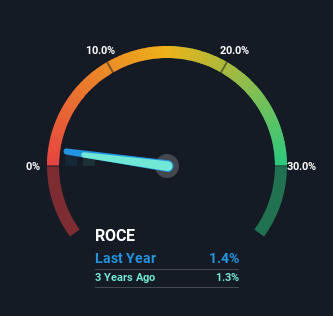
If you're not sure where to start when looking for the next multi-bagger, there are a few key trends you should keep an eye out for. Typically, we'll want to notice a trend of growing return on capital employed (ROCE) and alongside that, an expanding base of capital employed. Basically this means that a company has profitable initiatives that it can continue to reinvest in, which is a trait of a compounding machine. So on that note, Anik Industries (NSE:ANIKINDS) looks quite promising in regards to its trends of return on capital.
Return On Capital Employed (ROCE): What Is It?
For those that aren't sure what ROCE is, it measures the amount of pre-tax profits a company can generate from the capital employed in its business. Analysts use this formula to calculate it for Anik Industries:
Return on Capital Employed = Earnings Before Interest and Tax (EBIT) ÷ (Total Assets - Current Liabilities)
0.014 = ₹56m ÷ (₹4.6b - ₹522m) (Based on the trailing twelve months to December 2024).
Thus, Anik Industries has an ROCE of 1.4%. In absolute terms, that's a low return and it also under-performs the Trade Distributors industry average of 6.3%.
View our latest analysis for Anik Industries

While the past is not representative of the future, it can be helpful to know how a company has performed historically, which is why we have this chart above. If you'd like to look at how Anik Industries has performed in the past in other metrics, you can view this free graph of Anik Industries' past earnings, revenue and cash flow.
How Are Returns Trending?
We're delighted to see that Anik Industries is reaping rewards from its investments and has now broken into profitability. The company now earns 1.4% on its capital, because five years ago it was incurring losses. While returns have increased, the amount of capital employed by Anik Industries has remained flat over the period. So while we're happy that the business is more efficient, just keep in mind that could mean that going forward the business is lacking areas to invest internally for growth. After all, a company can only become a long term multi-bagger if it continually reinvests in itself at high rates of return.
One more thing to note, Anik Industries has decreased current liabilities to 11% of total assets over this period, which effectively reduces the amount of funding from suppliers or short-term creditors. This tells us that Anik Industries has grown its returns without a reliance on increasing their current liabilities, which we're very happy with.
What We Can Learn From Anik Industries' ROCE
As discussed above, Anik Industries appears to be getting more proficient at generating returns since capital employed has remained flat but earnings (before interest and tax) are up. Since the stock has returned a staggering 1,053% to shareholders over the last five years, it looks like investors are recognizing these changes. In light of that, we think it's worth looking further into this stock because if Anik Industries can keep these trends up, it could have a bright future ahead.
On a separate note, we've found 2 warning signs for Anik Industries you'll probably want to know about.
While Anik Industries isn't earning the highest return, check out this free list of companies that are earning high returns on equity with solid balance sheets.
New: Manage All Your Stock Portfolios in One Place
We've created the ultimate portfolio companion for stock investors, and it's free.
• Connect an unlimited number of Portfolios and see your total in one currency
• Be alerted to new Warning Signs or Risks via email or mobile
• Track the Fair Value of your stocks
Have feedback on this article? Concerned about the content? Get in touch with us directly. Alternatively, email editorial-team (at) simplywallst.com.
This article by Simply Wall St is general in nature. We provide commentary based on historical data and analyst forecasts only using an unbiased methodology and our articles are not intended to be financial advice. It does not constitute a recommendation to buy or sell any stock, and does not take account of your objectives, or your financial situation. We aim to bring you long-term focused analysis driven by fundamental data. Note that our analysis may not factor in the latest price-sensitive company announcements or qualitative material. Simply Wall St has no position in any stocks mentioned.
About NSEI:ANIKINDS
Excellent balance sheet very low.
Market Insights
Community Narratives



